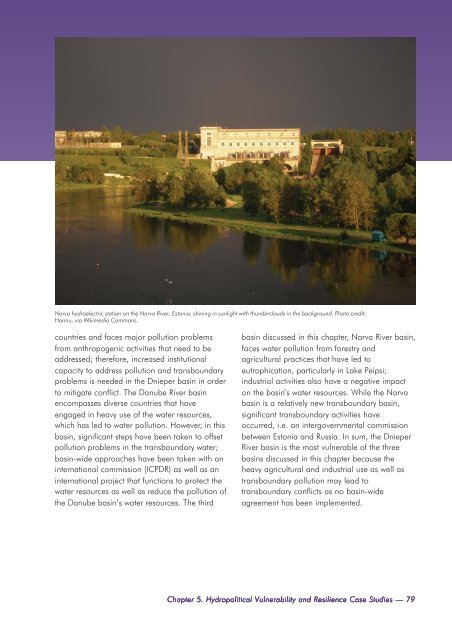Europe - UNEP
Europe - UNEP
Europe - UNEP
You also want an ePaper? Increase the reach of your titles
YUMPU automatically turns print PDFs into web optimized ePapers that Google loves.
Narva hydroelectric station on the Narva River, Estonia, shining in sunlight with thunderclouds in the background. Photo credit:<br />
Hannu, via Wikimedia Commons.<br />
countries and faces major pollution problems<br />
from anthropogenic activities that need to be<br />
addressed; therefore, increased institutional<br />
capacity to address pollution and transboundary<br />
problems is needed in the Dnieper basin in order<br />
to mitigate conflict. The Danube River basin<br />
encompasses diverse countries that have<br />
engaged in heavy use of the water resources,<br />
which has led to water pollution. However, in this<br />
basin, significant steps have been taken to offset<br />
pollution problems in the transboundary water;<br />
basin-wide approaches have been taken with an<br />
international commission (ICPDR) as well as an<br />
international project that functions to protect the<br />
water resources as well as reduce the pollution of<br />
the Danube basin’s water resources. The third<br />
basin discussed in this chapter, Narva River basin,<br />
faces water pollution from forestry and<br />
agricultural practices that have led to<br />
eutrophication, particularly in Lake Peipsi;<br />
industrial activities also have a negative impact<br />
on the basin’s water resources. While the Narva<br />
basin is a relatively new transboundary basin,<br />
significant transboundary activities have<br />
occurred, i.e. an intergovernmental commission<br />
between Estonia and Russia. In sum, the Dnieper<br />
River basin is the most vulnerable of the three<br />
basins discussed in this chapter because the<br />
heavy agricultural and industrial use as well as<br />
transboundary pollution may lead to<br />
transboundary conflicts as no basin-wide<br />
agreement has been implemented.<br />
Chapter 5. Hydropolitical Vulnerability and Resilience Case Studies — 79
















